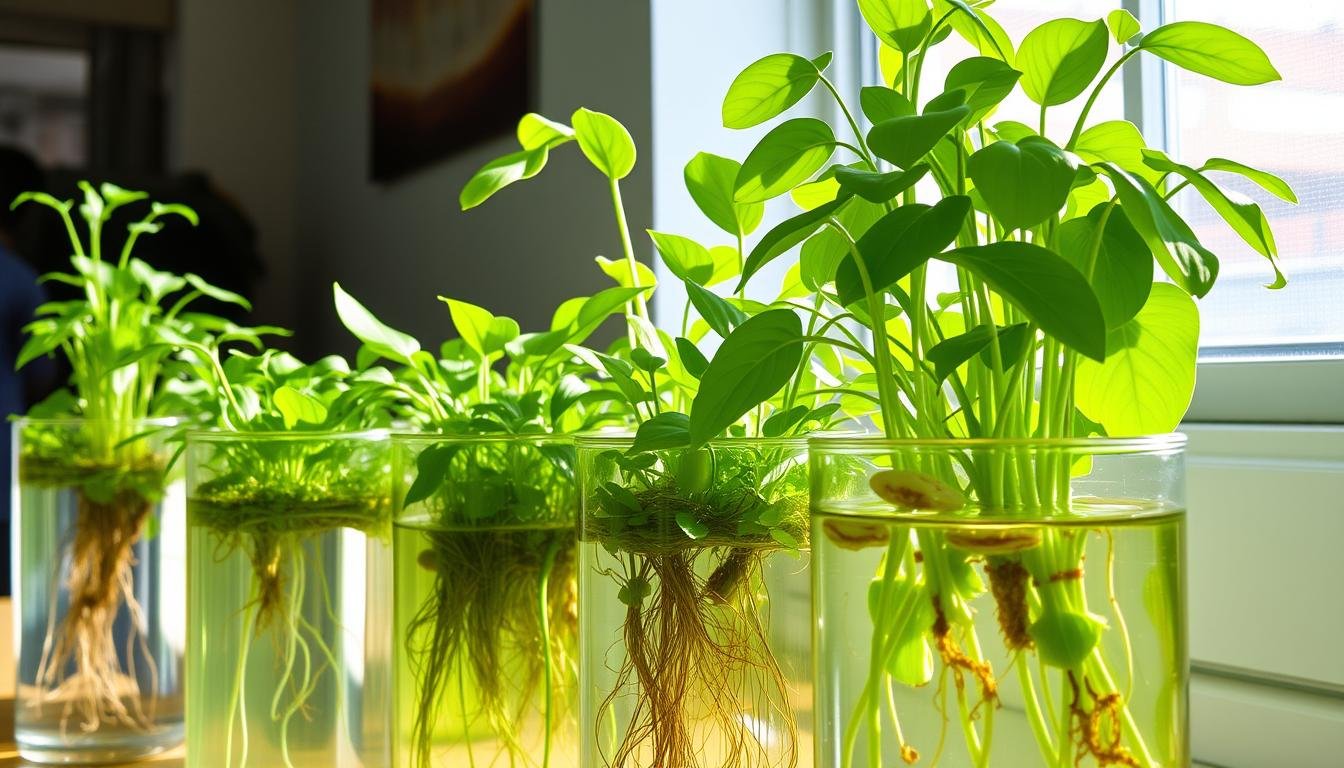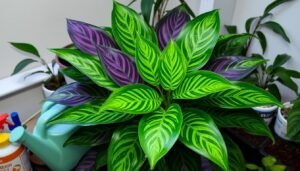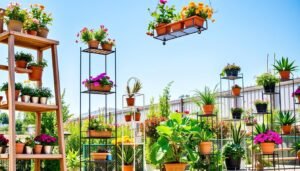Growing plants in water makes gardening easier and offers many benefits. Hydroponic gardening is a popular choice for those who want simple green spaces. It lets you care for plants without the mess of soil gardening.
This method has fewer pests, a cleaner space, and uses space well. It’s perfect for city living and busy lives.
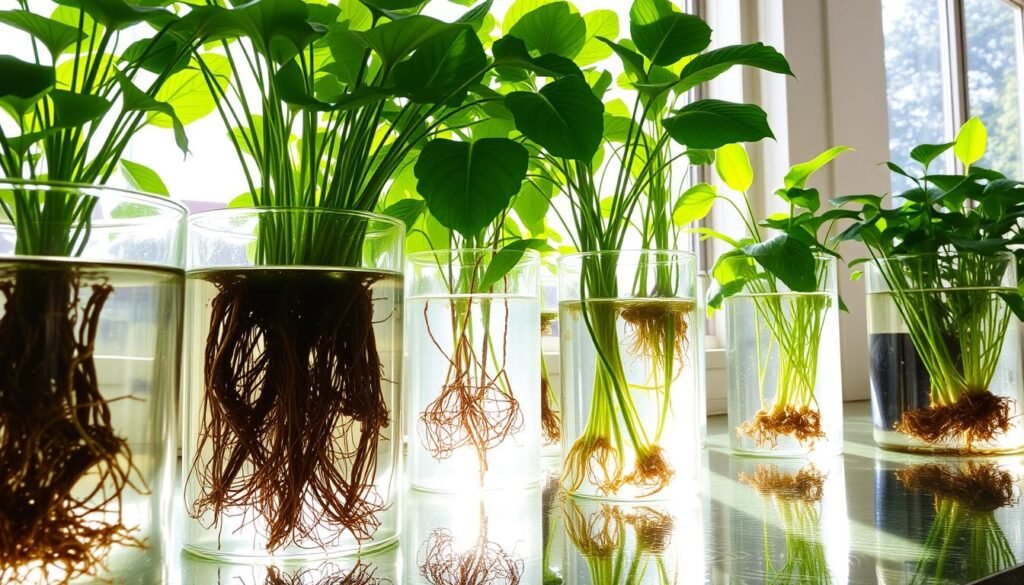
Also, growing plants in water can make them healthier. But, you need to use the right water and nutrients. Knowing about tap water issues and hard water effects is important.
Choosing soilless cultivation can change your gardening for the better. It helps your indoor plants stay healthy.
Key Takeaways
- Hydroponic gardening promotes easier maintenance and healthier plant growth.
- Utilizing the right water and nutrients is essential for successful water plants.
- Growing plants in water minimizes common gardening problems like pests and mess.
- Soilless cultivation is ideal for small spaces and urban living.
- Understanding your water source can enhance the growth of your plants.
Introduction to Hydroponic Gardening
Hydroponic gardening changes how we grow plants by not needing soil. It uses water full of nutrients to grow your favorite crops. This method is very efficient, saving up to 90% of water used in traditional farming.
In hydroponic systems, plants get their nutrients from water. This leads to faster growth and higher yields. A popular method, deep water culture, keeps plants in a solution full of oxygen. This ensures they always get the nutrients they need.
For city gardeners, hydroponic gardening is a great way to grow food without a big outdoor space. Systems can be small and work well in tight spots. The Flex Farm is a good example, producing over 394 pounds of fresh produce a year with little upkeep.
Water quality is key in hydroponic systems. Many use reverse osmosis water, which removes 98% of impurities. This is important because 85% of water in the US is hard water, and plants need clean water to thrive.
Hydroponic gardening fits well with sustainable farming, saving water and growing food in cities. It helps reduce our environmental impact and gives us fresh produce.
Benefits of Growing Plants in Water
Growing plants in water has many advantages, especially for those who are busy or live in the city. It’s a great way to garden without the hassle of soil. You’ll find several key benefits from using this innovative gardening method.
Low-Maintenance Gardening
One big plus is the low-maintenance aspect. Without soil, you don’t have to worry about overwatering, pests, or the mess of traditional gardening. Hydroponic systems make it easy to focus on your plants’ growth. The water delivers nutrients directly, leading to healthier plants with less work for you.
Space-Saving Gardens
For city dwellers, space-saving gardens are a smart choice. You can grow many plants in small containers filled with water, even without a big outdoor space. Hydroponic systems, like vertical stacking, make the most of your space. This lets you grow more plants in less room, enjoying all the benefits of water gardening.

Understanding Soilless Cultivation
Soilless cultivation is a new way to grow plants without soil. It uses hydroponic systems and aquaponics. These methods provide plants with water, nutrients, and the right environment to grow.
This method is great for saving space. Hydroponic systems can grow more plants in a small area. This is perfect for cities or small gardens where space is limited.
It also saves water. Nutrients go straight to the roots, reducing water waste. This means plants grow stronger and healthier.
Choosing the right growing materials is key. Jiffy Growbags and Jiffy Pellets create a good growing space. Jiffy’s Glowblocks add special lighting to help plants grow faster.
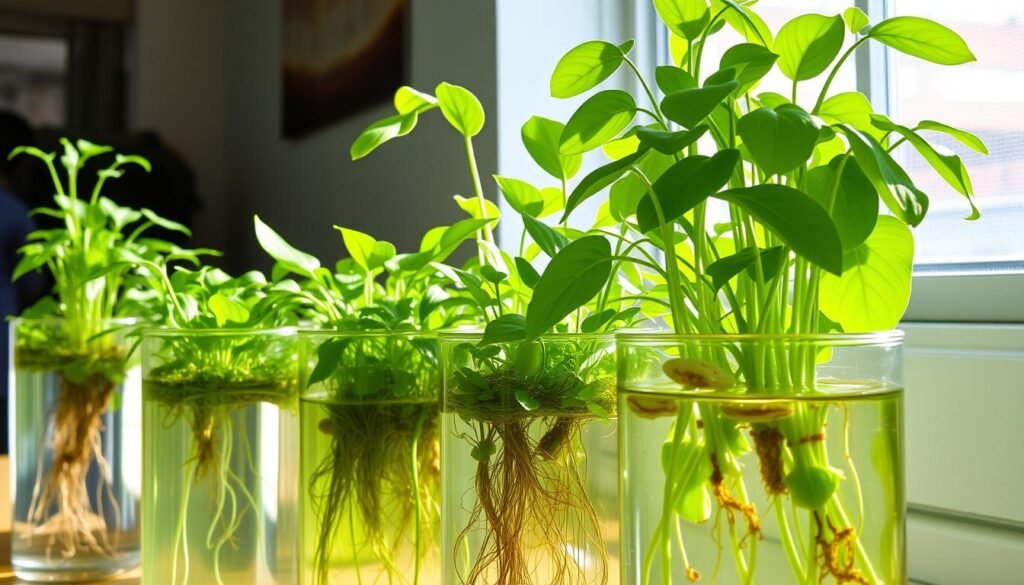
Soilless systems can be open or closed. Open systems don’t reuse nutrients, while closed systems do. This helps save resources and improve farming efficiency.
Soilless cultivation is becoming more popular. It’s a way to grow food that’s better for the planet. As our ecological footprint grows, this method helps us produce food sustainably.
Nutrient Requirements in Hydroponic Systems
To grow plants well in hydroponics, knowing what nutrients they need is key. Plants in hydroponics get all their food from nutrient-rich water, not soil. This means you must keep a close eye on the nutrients in your water and adjust them often.
Importance of Nutrient-Rich Water
Nutrient-rich water is crucial for plant growth in hydroponics. This water has all the nutrients plants need that they can’t get from soil. Nutrients like nitrogen, phosphorus, and potassium help plants grow strong and healthy.
Checking the water’s electrical conductivity (EC) regularly is important. This ensures your plants get the right amount of nutrients. Systems like Deep Water Culture (DWC) help deliver nutrients directly to the roots, which is great for growth.
Using Liquid Fertilizers Effectively
Using liquid fertilizers in your hydroponic system can greatly benefit your plants. These fertilizers are packed with nutrients, making it easier to feed your plants what they need. But, it’s important to follow the instructions on the fertilizer to avoid harming your plants.
Choosing the right fertilizer and adjusting it based on your plants’ growth stage is important. Keeping an eye on nutrient levels and adjusting your fertilizer use will help your plants thrive and produce well.
| Nutrient | Primary Function | Common Deficiency Symptoms |
|---|---|---|
| Nitrogen | Leaf growth and green coloration | Pale yellow leaves, stunted growth |
| Phosphorus | Root development and flower production | Dark green foliage, poor fruit set |
| Potassium | Water regulation and enzyme activation | Brown leaf edges, weak stems |
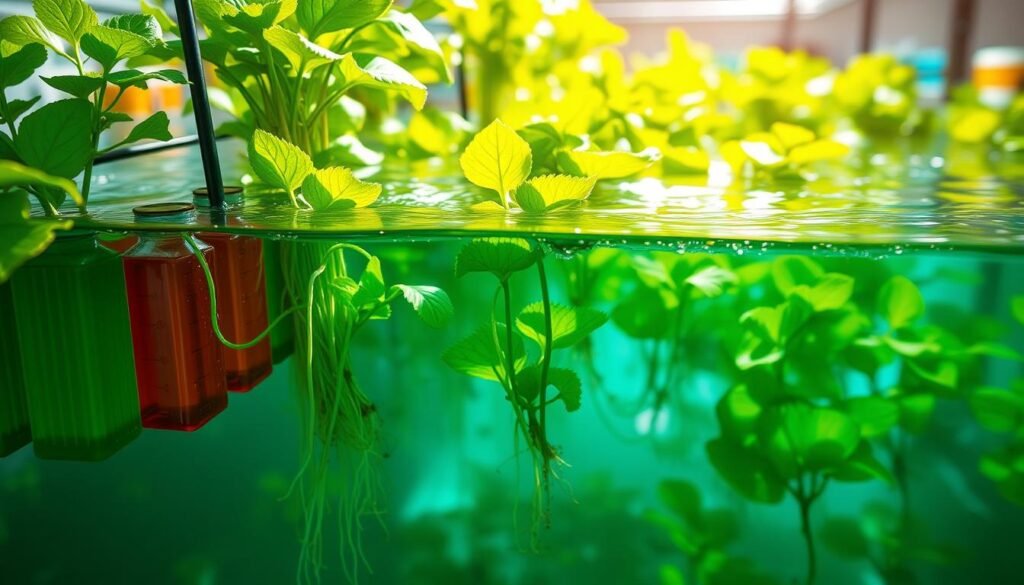
Indoor Gardening Solutions
Indoor gardening lets you bring life and color into your home. Using water, you can grow a variety of plants. These plants not only thrive but also make your space look better.
Best Indoor Plants for Water Growth
Many plants grow well in water, making them great for indoor gardens. Here are some top picks:
- Philodendrons
- English Ivys
- Pothos
- Begonias
- Arrowheads
- Hoyas
These plants look good in water and add beauty to your home. Use clear glass containers to show off their roots. This makes your garden visually appealing and functional.
Creating Aesthetic Displays with Water Plants
Creating displays with water plants can make any room stylish. Here are some ideas:
- Utilize clear containers—Show off the unique white roots that develop in water.
- Mix different plant types—Combine various species for a layered, intriguing look.
- Incorporate unique containers—Use decorative vases or bowls to enhance beauty.
- Experiment with height—Place taller plants alongside shorter ones for dimension.
These tips help you enjoy easy gardening and beautiful indoor decor. Make sure to change the water and keep it oxygenated. This will keep your plants healthy and your displays vibrant.
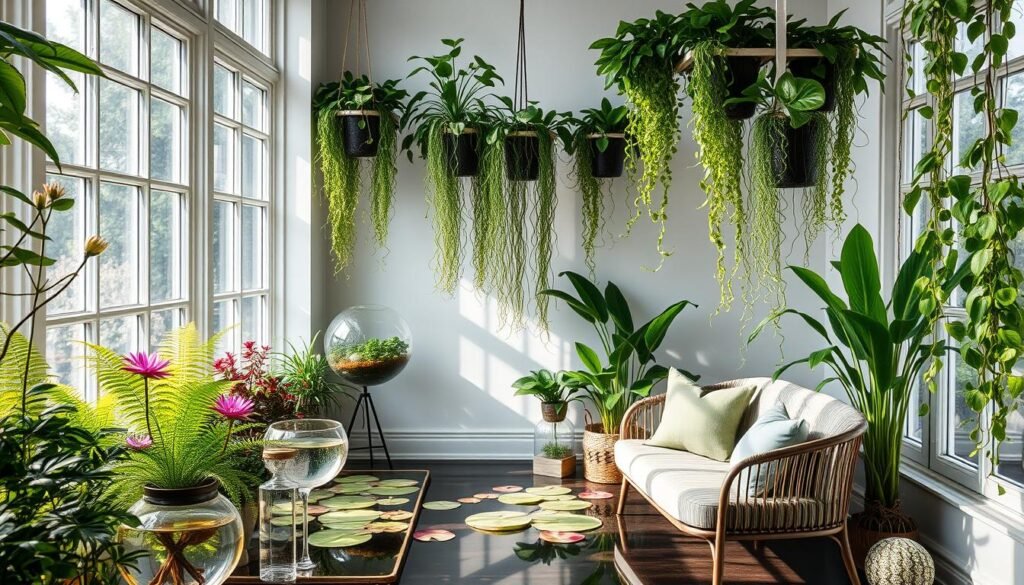
Water Conservation in Gardening
Water conservation in gardening is key in a world with less water. Only about 3% of Earth’s water is available for us. More than 70% of our planet is water, but most of it is saltwater. Using water wisely helps both the environment and your plants.
How Watering Needs Change with Soilless Cultivation
In soilless gardens, knowing how much water your plants need is crucial. Fruits and veggies, which are mostly water, need careful watering. Too much water can lower their sugar content and quality.
Adjust your watering based on your plants’ needs. These needs change with the weather.
Reducing Water Waste in Gardening Practices
Using methods to cut down on water waste can change your gardening. Soaker hoses can cut water use by half, providing targeted watering. Mulch keeps soil moist, protecting plants in dry times.
Planting drought-resistant plants like succulents saves water. Collecting rainwater in barrels also helps conserve water in your garden.
Fewer Pests with Water-Based Gardening
Water-based gardening is a great way to cut down on pests. It’s different from traditional soil gardening. This method leads to healthier plants and a more productive garden.
Eliminating Soil-Borne Pests
Hydroponic or water-based gardening gets rid of pests that live in soil. Plants in water don’t attract pests like fungus gnats. These pests love moist soil.
Water gardening also means less need for harmful pesticides. This makes growing plants more organic and natural. Plants in water have white roots that soak up nutrients well, helping them grow strong.
- Check the water often to stop algae, which pests like.
- Use a diluted hydrogen peroxide solution to clean plants if algae grows.
- Choose tough plants like Philodendrons and Pothos. They do well in water and keep pests away.
Water gardening helps you have fewer pests. It also makes your garden look great.
Propagation Techniques for Plant Growth in Water
Propagating plants in water is a fun way to grow your indoor garden. You can see roots grow in just a few weeks. Plants like Pothos, Philodendron, and Monstera do well with this method. Knowing the best practices helps you grow plants successfully.
How to Propagate Plants Successfully
To start, take cuttings from healthy plants. Make sure at least one leaf node is in clean water. This is key for root growth. Here are some tips to boost your success:
- Cut the stems at an angle to help roots grow.
- Use rooting hormone on the bottom 1.5 cms of each cutting to help it survive.
- Change the water in the container at least once a week to keep it clean and prevent stagnation.
- Look for signs of roots: move the cuttings to soil when roots are 3 to 5 cm long or start to develop side roots.
- Choose clear glass containers or vases to see root growth easily.
Many indoor plants, like English ivys and Hoyas, do well in water. This method saves water, using only one-third of what soil-based cultivation needs. Water-grown roots are white, which helps plants absorb nutrients better and keeps them pest-free.
Using these techniques makes growing plants in water fun and rewarding. It lets you enjoy lush greenery at home with little effort and care.
Best Containers for Growing Plants in Water
Choosing the right containers is crucial for growing plants in water. The best containers support your plants and make your indoor garden look great. You can pick from different materials and styles to create a unique look.
Choosing the Right Container Material
Think about using transparent containers to see the roots and water levels. Here are some good options:
- Vases: They come in many shapes and sizes. Narrow-necked vases are perfect for single-stem plants, offering support without blocking the view.
- Jars: Glass jars can be used for plant cuttings or long-term growth. They add a rustic, vintage look to your space.
- Glasses: Chipped or unused glasses can be turned into quirky, modern plant containers.
- Test Tubes and Wall Vases: These trendy options are great for vertical gardening and add a unique touch to your decor.
Creative Container Ideas for Your Plants
Looking for ways to make your plant display stand out? Try using upcycled containers. They’re good for the planet and can add personality to your home. Here are some ideas:
- Use old teacups or mugs for a cute touch.
- Try hanging containers made from mason jars for a vertical display.
- Decorative bowls, whether ceramic or metallic, can be a stunning centerpiece.
Choosing the right containers for growing plants in water is important. It helps keep your environment clean and makes caring for your plants easy. Remember, the look and function of your containers are both important when starting your water-gardening journey.
| Container Type | Material | Best for |
|---|---|---|
| Vases | Glass | Single-stem plants |
| Jars | Glass | Cuttings & Long-term growth |
| Glasses | Glass | Houseplants |
| Test Tubes | Glass/Plastic | Propagation & Aesthetic displays |
Common Challenges and Solutions
Growing plants in water is unique but comes with challenges, like algae growth. Algae love sunlight, which can harm your plants. Using the right methods can keep your plants healthy.
Managing Algae Growth in Water
Indoor gardeners often struggle with algae. It can steal nutrients and oxygen from plants. Here are ways to control algae:
- Limit Sunlight Exposure: Place containers in areas with indirect light to reduce algae proliferation.
- Regular Water Changes: Changing the water weekly helps to prevent algae buildup and maintains oxygen levels for the plants.
- Use of Filtered Water: Opt for filtered or rainwater instead of tap water to limit mineral deposits and chemical interactions that encourage algae.
- Hydrogen Peroxide Treatment: In severe cases, rinsing the container and using hydrogen peroxide can effectively eliminate persistent algae growth.
Learning these algae management tips is key to a healthy water garden. It prepares you for challenges and boosts your plants’ health.
| Strategy | Description | Benefits |
|---|---|---|
| Limit Sunlight Exposure | Reduce direct sunlight on container | Minimizes algae growth |
| Regular Water Changes | Change water every week | Prevents buildup, oxygenates water |
| Use of Filtered Water | Utilize filtered or rainwater | Reduces minerals and chlorine |
| Hydrogen Peroxide Treatment | Rinse and treat severe algae cases | Eliminates persistent growth effectively |
By using these strategies, you can create a perfect environment for your plants. It helps overcome common challenges.
Conclusion
Exploring the benefits of growing plants in water opens up a world of possibilities. This method is great for both new and experienced gardeners. It’s low-maintenance and makes your living spaces look lush and vibrant.
By using sustainable gardening practices, you help the environment. This is especially important in cities where space is limited. It helps you live greener.
Hydroponic systems let you grow plants all year, without worrying about seasons. They use space well and help you grow more per square foot. This is perfect for city living.
These systems also use less pesticides. This means healthier plants and less harm to the environment. It’s a win-win.
Knowing about water quality and watering techniques is key to a successful indoor garden. With the right setup, you’ll enjoy many benefits. Start with hydroponics and watch your garden grow in amazing ways.

